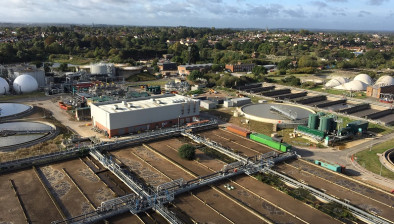England: New homes to run on ‘poo power’
Excess heat recovered from the sewage treatment process could be used to power more than 2,000 homes thanks to a new carbon-cutting partnership between Thames Water and Kingston Council.
The ‘poo power’ scheme is the first of its kind in England and has the potential to provide clean, green heating to new homes as part of the regeneration of Kingston’s Cambridge Road Estate. The project is expected to be a model for similar schemes elsewhere in the UK, reducing millions of tonnes of carbon emissions.
The UK Government and Greater London Authority have funded feasibility studies and design work for the project over the last two years, and an application has been made to the Government for capital funding. The result will be formally announced in March.
Under the plans, heat recovered from the final effluent of the sewage treatment process at Hogsmill will be captured before water is returned to the river, concentrated and supplied to local buildings from a state-of-the-art energy centre to be built on site.
If successful, up to seven gigawatt hours of low carbon heat per year could be supplied via a sealed network of pipes to the district heating system at the new Cambridge Road Estate. The aim will then be to expand the network to include public and commercial buildings in Kingston town centre.
Sarah Bentley, Thames Water’s chief executive officer, said: “We’re delighted to be working with Kingston Council, offering low carbon energy to a new housing development near to our works. Renewable heat from our sewer network is a fantastic resource, so it’s vital we are a leading player in energy transition and unlock the full potential of ‘poo power’.
“Protecting and enhancing the environment is extremely important to us, and we have committed to doing all we can to find new and innovative ways to achieve our net zero ambitions over the next 10 years. We’re already self-generating substantial amounts of renewable energy across our vast estate, meeting around a quarter of our total electricity needs, and are confident innovative district heating schemes like this will offer many more opportunities to ensure we leave our planet in a better place for future generations.”
Cllr Caroline Kerr, leader of Kingston Council, said: “This is ground-breaking. It’s a first for England and shows we are serious about reducing carbon in the borough. This is a real opportunity to be bold and ambitious for future generations. It’s great to be working alongside Thames Water to make waste into clean energy.
“The regeneration of Kingston’s largest council estate, Cambridge Road Estate, is a fantastic opportunity to make new homes in Kingston among the greenest in the country. We will continue to work alongside a range of partners to make green, sustainable energy a reality for Kingston.”
The renewable heat project at Hogsmill is estimated to save 105 kilo tonnes of carbon dioxide equivalent (ktCO 2e) emissions over 30 years – the equivalent of 157,000 return flights from London to New York or more than 15,000 car journeys around the world – and is the single largest carbon reduction scheme in Kingston. Future phases of the district heat network are planned to save additional emissions and help Kingston Council achieve its target of being carbon neutral by 2038.
Along with the heat transfer scheme, Thames Water is exploring other green energy projects at its Hogsmill site, which serves 380,000 customers, including solar panels and electric vehicle charging points.
Poo power, together with wind and solar, currently generates around a quarter of the company’s electricity needs, saving around £40 million in energy costs each year. In December, Thames Water produced enough renewable electricity across 24 sewage works to power the equivalent of more than 110,000 homes, 15 per cent more than was being produced three months previously. The company is due to announce its roadmap to achieve net zero carbon emissions by 2030 later this year.








